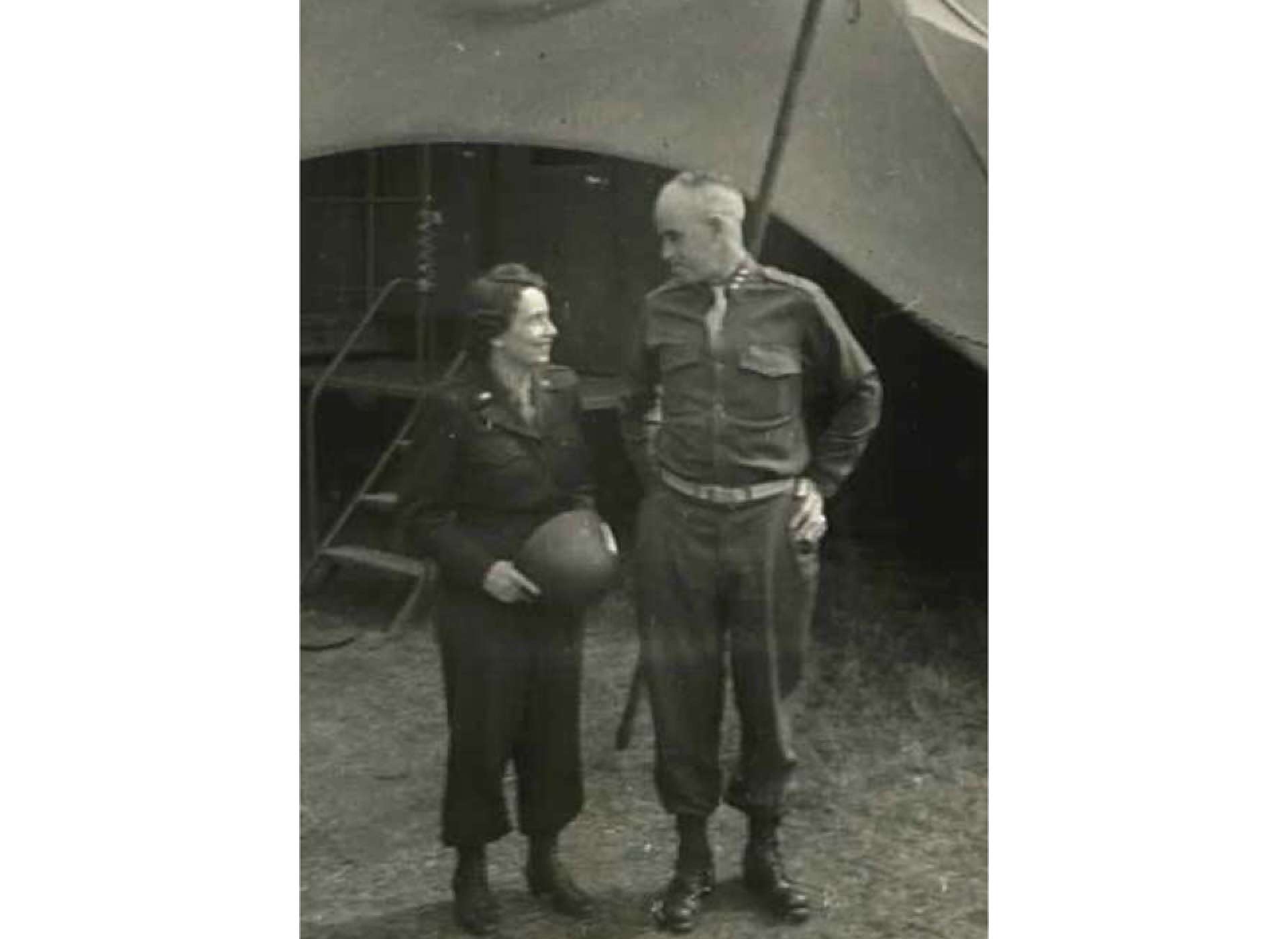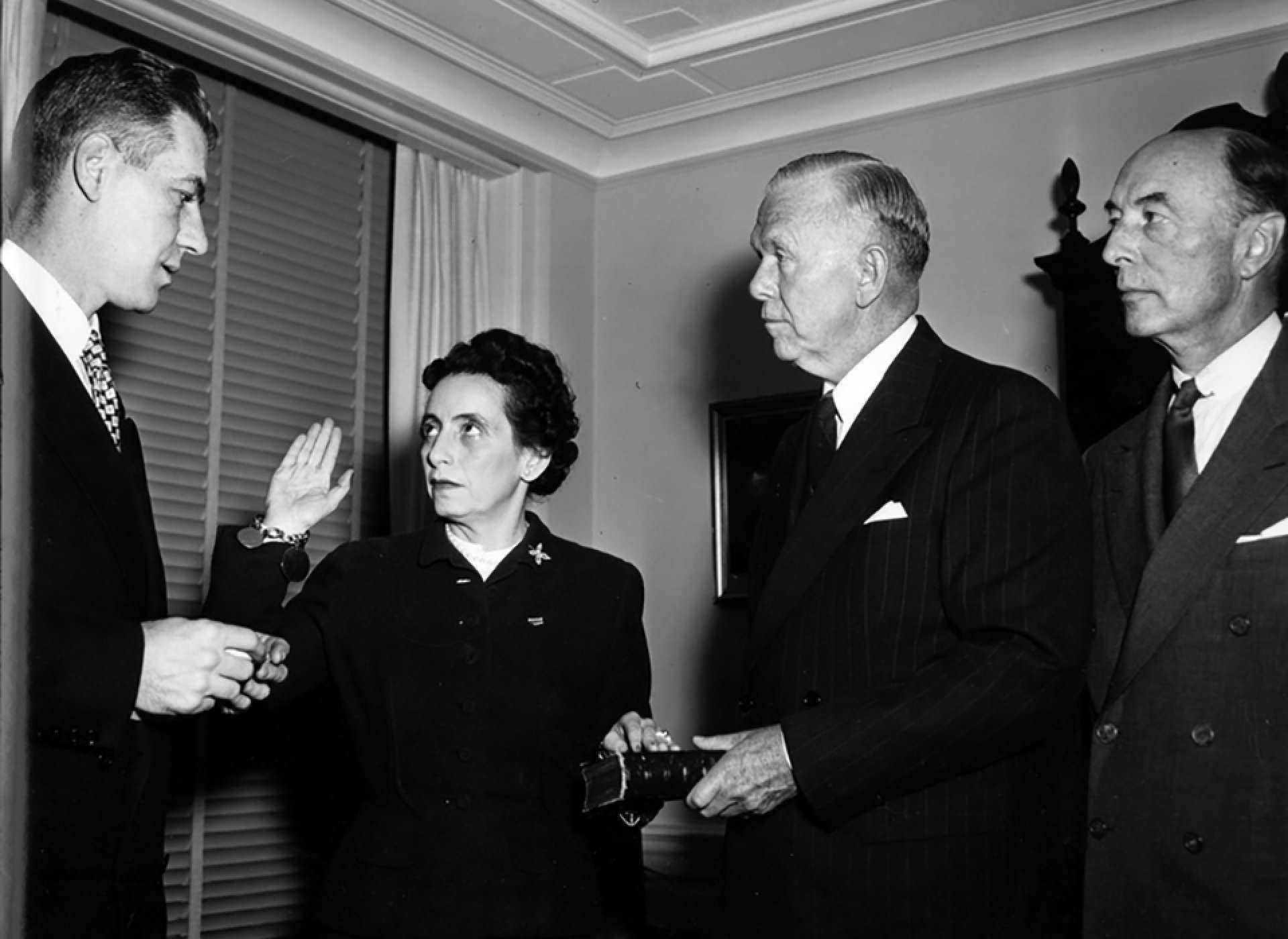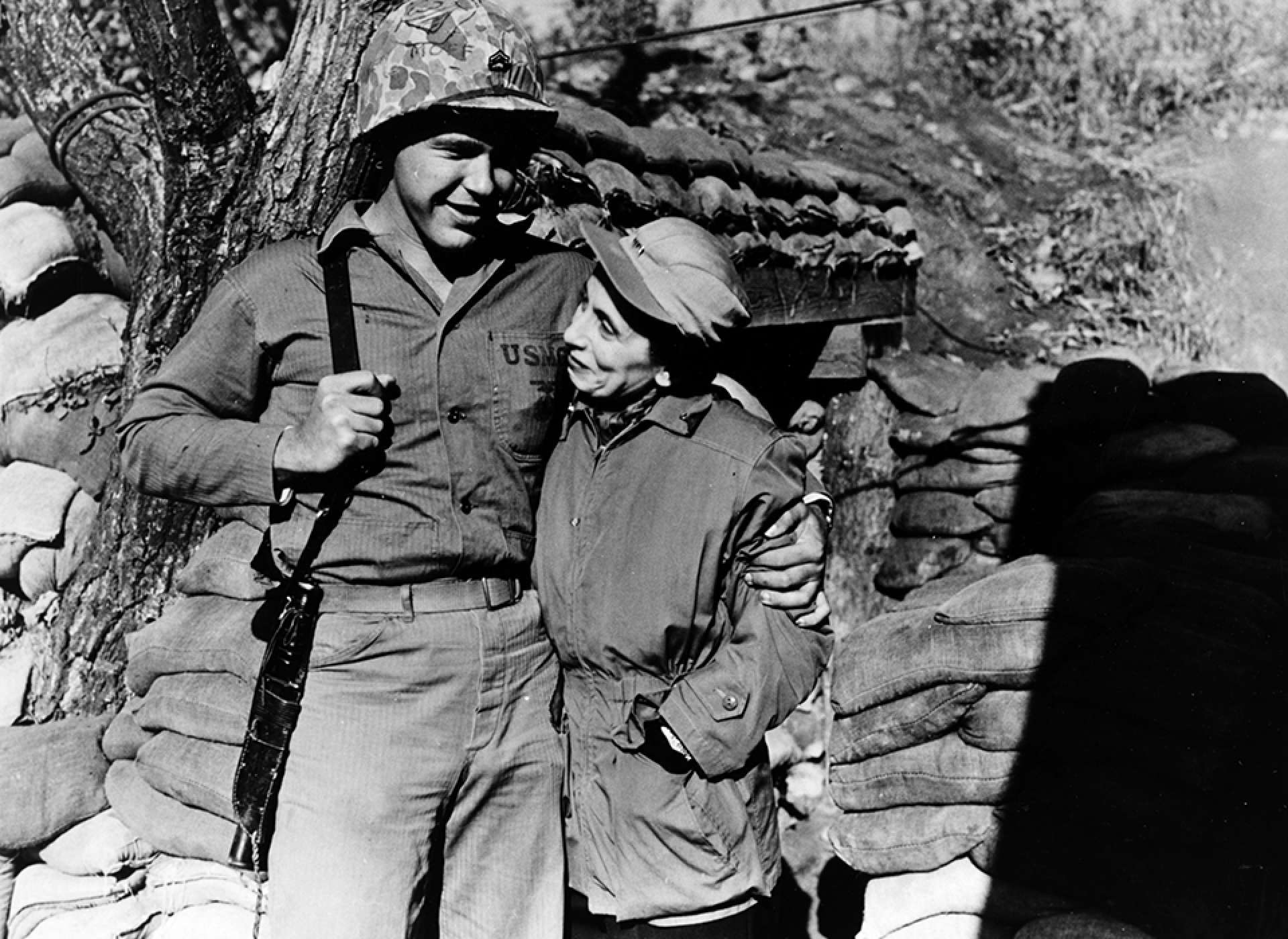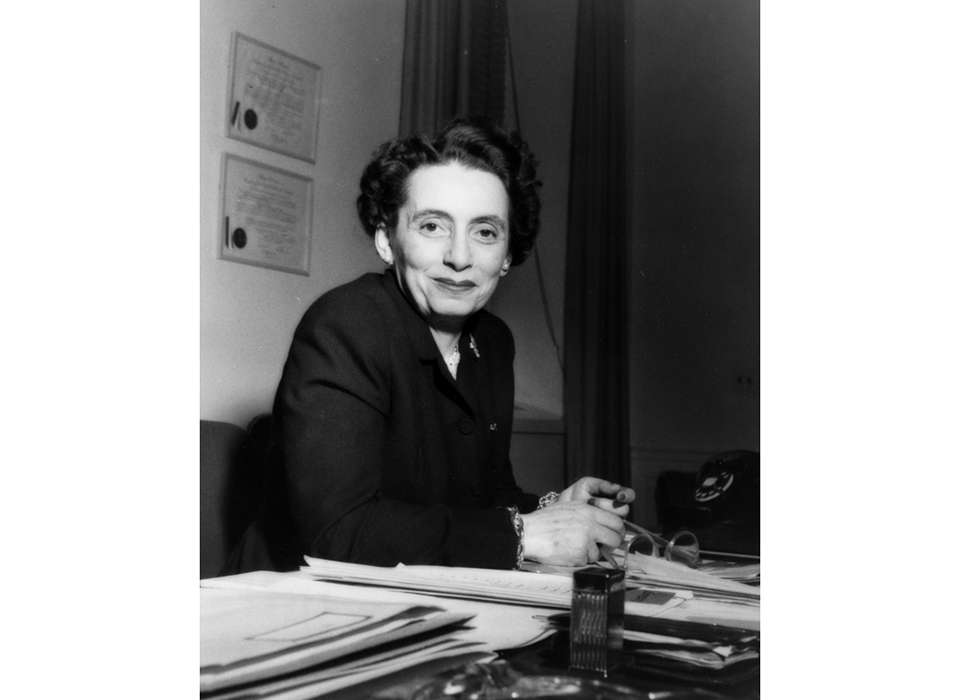Top image is a portrait of Anna M. Rosenberg, Assistant Secretary of Defense, at her desk in the Pentagon, February 2, 1951. Courtesy of the US Army and Harry S. Truman Library & Museum, 97-1847.
How did a Jewish American girl from the Bronx who never graduated from high school grow up to become the first woman to serve as Assistant Secretary of Defense in 1950? Anna M. Rosenberg’s meteoric rise from local politics, to the highest position in defense ever held by a woman at the time, lies in her dedication to the American men and women who served in the military during World War II and her skillful oversight of wartime mobilization and manpower issues.
From an early age, Rosenberg, who migrated with her family from Hungary to New York City in 1912, was a firm supporter of both America’s war effort and women’s rights. Inspired by her parents’ dedication to civic groups in the Jewish American community in the Bronx, she organized the Future Voters’ League with similarly-minded schoolmates to support women’s suffrage at age 12. Later during World War I, she volunteered at a military hospital and sold war bonds before marrying a soldier and becoming an American citizen in 1919.
Following the war, Rosenberg carried her interests in public relations and social causes into the private sector. Her activism in women’s suffrage caught the attention of New York City politicians, and she used this recognition as a springboard into her own foray into Democratic Party politics as a strategist for candidates campaigning for city council positions.
Many of the candidates she worked for were business owners who needed a public image that highlighted their abilities to work with both labor activists and union leaders. Drawing on this campaign experience, Rosenberg founded her own public relations consulting firm in 1922 in New York City. She often represented department stores, clothing factories, and other manufacturers who sought to improve their reputations when it came to labor relations.
Meanwhile, she also developed close relationships with union leaders from the American Federation of Labor, the New York Building Trades Union, and the Amalgamated Union of Clothing Workers. Rather than taking an aggressive, anti-labor stance when representing her high-powered clients, she specialized in mediation as a tactic in resolving disputes between employers and employees and bringing all parties to the table. Rosenberg’s ability to negotiate labor disputes among a variety of stakeholders caught the attention of Mayor Fiorello LaGuardia in 1933 who welcomed her into his administration as an industrial labor relations advisor.
Rosenberg’s political relationship with LaGuardia, and ability to navigate thorny labor situations, connected her to President Franklin D. Roosevelt’s New Deal administration during the Depression. She served as a regional director for the National Recovery Administration that was established in 1933 to bring together various sectors of the economy to support fair business and labor practices. This appointment catapulted her into increasingly more important New Deal roles, including New York regional commission for the Social Security Board. While regional commissioner, she also served as a consultant on state and local-level committees with LaGuardia, continued to run her consulting firm, and oversaw a massive study on labor relations commissioned by FDR.
Her work on personnel and labor issues directly led to one of her most important appointments during World War II: a regional director of the War Manpower Commission (WMC). FDR established the WMC with Executive Order 9139 on April 18, 1942 to coordinate various sectors of the wartime economy including industry, agriculture, and the armed forces to sustain production of crucial war materiel. Though no women served on the main WMC in Washington, DC, Rosenberg was the first woman to hold a regional directorship from 1942 through 1945, where she reported on labor relations and advised on issues of racism and discrimination in wartime industries.
Later in 1944, Rosenberg became a member of the advisory board for the Office of War Mobilization and Reconversion (OWMR), an agency responsible for “unifying and coordinating all governmental programs relating to war mobilization and peacetime conversion.” Through this position she became connected with high-ranking men in the military and in FDR’s administration who were affiliated with the OWMR, including future military governor of Germany General Lucius D. Clay and Secretary of State J F. Byrnes. She also discussed labor shortages on the Home Front with Army Chief of Staff General George Marshall in her role as an advisor.
But it was her assignment as FDR’s Special Representative to the European Theater of Operations (ETO) from August through September 1944 that would build her reputation as an influential go-between for civil-military relations. By 1944, FDR realized that the vast number of men serving overseas would need to be reintegrated into civilian life when they returned home. As ETO representative, Rosenberg conducted a series of interviews with servicemen and discovered that most were interested in pursuing the educational opportunities that would be available to them with the recently-signed GI Bill. Armed with her data, Rosenberg recommended that the military work with civilian agencies to develop educational and vocational programs to assist recipients of GI Bill benefits.
After Roosevelt died in April 1945, President Harry Truman reappointed her as his own representative in the ETO. This time she was sent to Europe after V-E Day to investigate the impact of demobilization and servicemen returning home on manpower issues that could jeopardize postwar occupation policies.

Anna Rosenberg with General Omar Bradley, 1944 during her role as ETO representative. Courtesy of Thomas Rosenberg, Jewish Women’s Archive.
At the end of World War II, Anna returned to her consulting firm, but not before being tapped by President Truman to use her experience with the troops in addressing another issue: universal military training. With rising Soviet-United States tensions following the war, Truman considered compulsory, universal military training (UMT) as an alternative to the draft for military preparedness in an increasingly uncertain global arena.
On November 20, 1946, Truman appointed Rosenberg to the President’s Advisory Commission on Universal Training—and she was the only woman on an eight-member panel. Her expertise in the social aspects of the military proved invaluable to the mission of investigating the feasibility of Truman’s plan. Though ultimately unsuccessful in securing UMT, Rosenberg’s contributions to the committee did not go unnoticed by General George Marshall who became an admirer of her skills and experience in politics and military affairs.
Once Marshall assumed the position of Secretary of Defense in the new Department of Defense (DOD), he offered to nominate Rosenberg as his new Assistant Secretary of Defense of Manpower and Personnel. She accepted, but Marshall warned that as a woman and a former New Dealer—whose appointment required approval by powerful Republicans in Congress who held doubts about Democrats’ abilities to take a strong stance against the Soviet Union—her road to confirmation by the Senate Armed Services Committee would be challenging.
On November 15, 1950, Anna was sworn in as interim Assistant Secretary of Defense for Manpower and Personnel, officially becoming the first woman to hold such a high-ranking position in the Pentagon. But Rosenberg’s troubles mounted in the early Cold War era. Though she quickly got to work, she faced immense opposition from some members of Congress in her confirmation hearings.
This was the era of “McCarthyism,” named after Senator Joseph McCarthy, who oversaw hearings on individuals he deemed subversive and potential security risks because of their former, current, or suspected ties to communists and Soviet sympathizers. Rosenberg’s past activities, including supporting unions and civil rights organizations before the war as a New Dealer, qualified her for an investigation. As did her last name, which often drew immediate connections to convicted Soviet agents Julius and Ethel Rosenberg.
Additionally, individuals wrote to the committee charging Anna with being a former member of the Communist Party of the United States of America, citing membership rolls as evidence. Rosenberg, however, informed the committee that there were many Jewish women in New York named “Anna Rosenberg,” and that she was never a communist. Despite these obstacles, the Senate Armed Services Committee confirmed Anna’s appointment, and she was sworn into office on November 29, 1950.

Anna M. Rosenberg being sworn in as Assistant Secretary of Defense with Felix Larkin (left) General Counsel of the Department of Defense, General George C. Marshall (second from right), and Robert A. Lovett, (right), Deputy Secretary of Defense, November 15, 1950. Courtesy of the Department of Defense and the Harry S. Truman Library & Museum, 97-1860.
While Assistant Secretary of Defense, Rosenberg was a champion of women in the military. In order to send more men to the front lines of the Korean War, Anna called on a WWII tactic to address manpower challenges: recruit more women to fill clerical and medical positions to release more men for combat. She recognized that there was still a stigma against women who served and chose a military career over a life with family and children at home.
To counter these negative perceptions, she established the Defense Advisory Committee on Women in the Services (DACOWITS) in 1951. The DACWS consisted of an all-women board of civic and military leaders, journalists, and entrepreneurs who met to discuss ways to promote a positive image of women who served in the military through advertisements and informative pamphlets. Though DACOWITS did not result in any major policy changes at the time, it is still active today and was proof of Rosenberg’s influence in emphasizing women’s roles in the military and the Department of Defense.
From 1950 through 1953 (when President Eisenhower appointed Charles Erwin Wilson as Assistant Secretary of Defense), Anna oversaw the challenging process of integrating previously segregated troops and continued to address military personnel obstacles. She also directed the implementation of the National Security Act of 1947, which established the National Security Council and the Central Intelligence Agency.

Anna M. Rosenberg as Assistant Secretary of Defense with Staff Sergeant George A. Moffett, USMC, during a tour of the Armed Forces in Korea, November 9, 1952. Courtesy of the Naval History and Heritage Command, 80-G-477066.
When she left the Department of Defense in 1953, she returned to her successful private practice, but remained a force in public policy. In the early 1960s, Anna served on the New York City Board of Education, as well as the United National Association, before President Lyndon Johnson invited her to become a member of the Council on Income Maintenance and assist with analyzing the success of various welfare programs in 1968. She also remained a dedicated supporter of Jewish American charity organizations until her death in 1983.
Secretary Rosenberg’s time in office was a testament to the changing roles of women in the military as a result of World War II. Though she still faced challenges as a woman who carried “both a purse and a briefcase” to her meetings in the Pentagon in a male-dominated world, she left a lasting mark on the postwar Department of Defense.
Stephanie Hinnershitz, PhD
Stephanie Hinnershitz is a historian of twentieth century US history with a focus on the Home Front and civil-military relations during World War II.
Cite this article:
MLA Citation:
APA Citation:
Chicago Style Citation:





![Max Fuchs, New York City cantor, sings as Rabbi Sydney [sic] Lefkowitz, Richmond, VA, conducts the first Jewish services from Germany.](/sites/default/files/styles/max_650x650/public/2025-10/image1.jpg)



